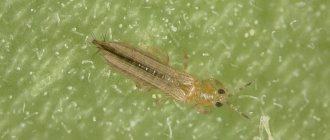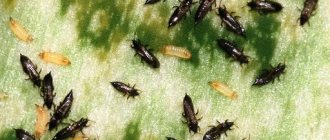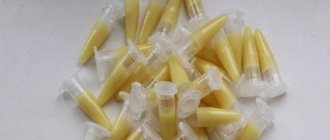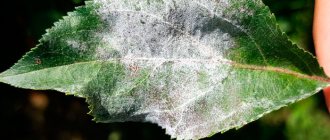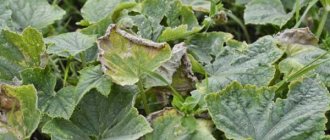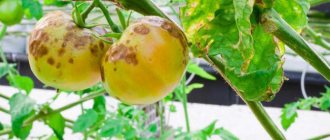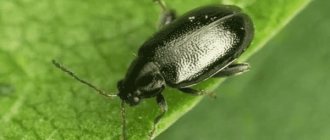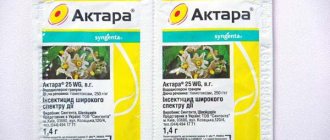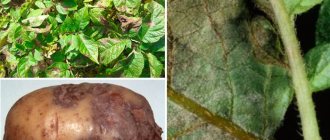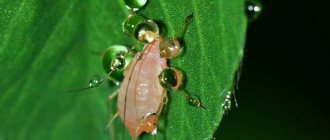Related Posts
- What to do if your child has lice? How to get them out?
- What is Ixodid tick? What are the dangers for humans, control measures
- Mites on cucumbers: what to treat, the most popular preparations for the pest
Good afternoon dear friends! We have a good friend who really loves indoor flowers. They have so many of them in their house that it seems like too much. But when violets, begonias, orchids and fuakarias begin to bloom, all the beauty cannot be described.
We visit them very often. Once again, when we came to them, we noticed that the number of plants had decreased, and some of them looked sick with something. Tamara told about an unpleasant story. It turns out thrips have appeared on her indoor plants.
All means were used to combat the pest, and what we saw were already the consequences, and the worst thing happened before. In this article you will learn: thrips on indoor plants - how to fight them, methods for properly processing flowers, the damage caused by the pest.
General provisions
Flower thrips or Western flower thrips, also called California flower thrips, are small, rarely exceeding 1.5 mm in length and have a huge appetite, members of the multi-species order of thrips. Photos and descriptions of thrips species can be found here.
This species, Frankliniella occideantalis, was first described by the American entomologist Theodore Pergande in 1895.
Flower thrips are very dangerous parasites that feed on the cell sap of plants , active in the dark and during the day preferring to hide under leaves, in flower buds or in the upper layers of the soil.
Thrips have several stages of development. The female lays up to 300 eggs in leaves, flowers or stems, developing in 2–4 days at a temperature of +25°C and up to 11 days at +15°C. The first two larval stages feed on the surface of the leaves, two more go under the surface of the soil, closer to the roots, from where, after 2–3 days, an adult individual capable of reproduction appears.
Western thrips is widespread and, thanks to trade, was brought to almost all countries and continents, and although it is most popular in the mid-latitudes of the subtropics, it also lives in other climatic zones where there is no high humidity and too low temperatures. In Russia, the pest is included in the list of quarantine objects with limited distribution.
Remedies for thrips (preparations)
In order to definitely get rid of thrips, you will have to resort to treating plants with chemicals. Which ones are the most effective? And which are the least harmful to humans? We offer you a brief description of insecticidal preparations on sale.
- Scale insects: how to fight on indoor plants and in the garden
- Agravertin is a biological preparation of enteric contact action that is highly effective in the fight against sucking insects. Consumption – 5 ml per half liter of water;
- Aktara is a highly effective insecticide of enteric contact action, quickly absorbed by the plant;
- Actellik is an organophosphorus insecticide with a broad spectrum of contact-intestinal action against leaf-eating, sucking pests and mites. Consumption – 1 ampoule per 1 liter of water;
- Vertimek is an insectoacaricide of enteric contact action for the protection of plants in closed ground, as well as indoor plants. Consumption – 2.5 ml per 10 liters of water;
- Decis is a broad-spectrum contact insecticide against leaf-eating and sucking pests, destroying both adults and larvae;
- Imidacloprid is a chemical insecticide used in the control of harmful insects. Imidacloprid is used as an active ingredient in many modern drugs;
- Inta-vir is a drug for killing insects in vegetable gardens, orchards and greenhouses, safe for pets and people. Consumption – 1 tablet per 2 liters of water;
- Golden spark is a highly effective insecticidal agent against insect pests;
- Karate is a contact insecticide that is highly effective in pest control. Consumption – 0.5 ml per 2.5 liters of water;
- Karbofos is a moderately toxic pesticide against pests of fruits, citrus fruits, vegetables and grapes. Consumption – 15 g per 2 liters of water;
- Mospilan is a fast-acting systemic insecticide that destroys pests at all stages of development;
- Spintor is a drug of biological origin that has a unique mechanism of action against a huge number of pests;
- Fitoverm is a biological preparation that is a product of the vital activity of soil microorganisms and protects indoor plants from pests. Consumption – 2 ml per 200 ml of water;
- Fufanon is a broad-spectrum organophosphorus insecticide with contact, intestinal and fumigate effects.
How to recognize them?
The pest is quite easy to recognize. Thrips has an elongated body, thin legs and extraordinary mobility. The color is yellowish or light brown, males and females are of the same size. Like most plant-parasitic insects, thrips have piercing-sucking mouthparts that can pierce the skin of a leaf and get to the sap.
Adults have wings, are capable of making very long flights and easily jump from one plant to another. The larvae are almost no different from mature individuals, they are smaller, up to 1 mm, they do not have wings, their legs are not as mobile and shortened, and their color is lighter.
Insects can be detected on a houseplant on leaves, in buds and soil , as well as by the products of their vital activity - small black dots. The most obvious sign that a plant is infected is damage caused by flower thrips.
Thrips pest - description
The length of the black, brown or gray body of thrips reaches from 0.5 to 3 mm, some species are much larger - about 14 mm. The legs of thrips are running, the mouthparts are asymmetrical, piercing-sucking, and the paws are without claws, but are equipped with teeth and a bubble-like suction device. The abdomen of thrips consists of 11 segments. There is fringe along the edges of the wings. Thrips develop through five stages: eggs, larvae, pronymphs, nymphs and adults. Thrips larvae have a grayish or white-yellow body, otherwise they differ from adults only in the absence of wings.
Thrips are polyphages, that is, omnivorous insects. They are one of the most common pests of agricultural, vegetable, fruit, ornamental and indoor crops. They pose a particular danger to plants indoors: if thrips are infested in greenhouses, it is very difficult to get rid of them; you can only contain their population numbers. It is difficult to detect these pests due to their small size and secretive lifestyle: they can parasitize one plant for a long time without spreading to neighboring ones.
Adults and larvae suck the sap from the above-ground parts of the plant and infect them with their secretions. First, discolored or yellowish spots, streaks or stripes appear at the bite sites, which gradually merge. As a result of the activity of pests, plant tissue dies, holes form in place of the spots, leaves wither and fall off, flowers lose their decorative effect and fall off prematurely. When a plant is massively occupied by thrips, silvery areas appear on its ground organs, the stems are bent, and the flowers are deformed due to the fact that the pests have damaged the flower buds. On top of that, thrips are carriers of incurable viral diseases.
- Wireworm in the garden: how to get rid of it, how to fight it, how to treat it
Harm and features of the fight
General signs of infection:
- The formation of small dark or discolored dots on the surface of the leaves - traces of insect bites that die off after the loss of cell sap.
- Premature wilting, bending of stems and leaves, deformation or too small size of opening flowers and buds during the growing season.
- The presence of traces of the pest’s activity – a silvery cobwebby or white coating that interferes with normal photosynthesis.
- The appearance of a streak-like network, connecting into solid brown or brown spots, forming gaps, causing the leaves and buds to dry out and die.
Important : In addition to the direct harm caused by the parasite and its larvae, they also carry dangerous viral diseases that affect plants.
The danger also lies in the fact that thrips multiply very quickly on flowers, and as the population grows, the likelihood of plant death also increases. If measures to destroy the pest are not taken in time, the flower may die, and when finished with one, thrips will immediately move on to the next. We talked in detail about how to deal with these insects in this article.
Violet
A violet affected by flower thrips dries out almost immediately . This is especially dangerous because, due to its structure, the presence of insects can be detected already in a dying state. The violet suffers mainly from larvae that infect the anther, which leads to the withering of unopened buds and prevents the formation of new ones.
Signs:
- leaves droop;
- traces of drying may appear;
- edges curl;
- Pollen is rapidly falling from the opened buds.
The fight against insects that attack a violet begins with the quarantine of the infected plant.
- It is separated from others, preferably in a room without any greenery.
- After isolation, the violet is treated with an insecticide solution intended specifically for flower thrips and covered with a plastic bag.
- After a day, the bag is removed, and leaving the flower in isolation, they continue with normal care.
- Two weeks later, the procedure is repeated to get rid of any surviving larvae.
Ficus
On Ficus Benjamin, in the presence of thrips, the leaves begin to turn yellow , dry out over time and fall off. Without the ability to obtain nutrients, the plant itself dies. To destroy the parasite, insecticides are used, which are sprayed onto the leaves several times after a certain period of time.
Attention: The selection of chemicals is made strictly for indoor plants, in order to avoid the risk of poisoning.
Rose
On roses, thrips most often settle in unopened buds, feeding on their cell sap and causing the flowers to not open and quickly dry out.
To combat the pest on garden roses, the root system of the plant is treated with a chemical solution once every 10–14 days . It is prohibited to spray buds growing in the garden, because all insecticides are also poisonous to bees. In the case of indoor roses, there are no such restrictions, and its buds are treated along with the roots, but the most effective way is to spray the roots. Infected flowers are also pruned, which reduces the number of insects and the rate of population growth.
Phalaenopsis
Thrips cause the same damage to orchids as they do to most plants. Phalaenopsis leaves become covered with a thin film, wither and die. Flowers and roots are damaged.
- before using the poison, the orchid is “bathed” in warm water;
- remove areas damaged by the parasite;
- spray several times, repeating the steps every 10 days until the phalaenopsis recovers.
You will learn more about where thrips on an orchid come from and how to deal with them in a separate article.
Cyclamena
For cyclamen that has come under attack from pests, along with the usual symptoms, it is also characteristic that the leaves curl upward. They destroy insects, as in the case of an orchid:
- a warm shower is used;
- Not only the damaged areas are cut off, but also all leaves and flower stalks affected by the parasite;
- after which the cyclamen is washed, dried and treated with insecticides 2 - 3 times a week.
If cyclamen seeds are infected, then flower thrips can be transmitted along with them , from where they are selected at high temperatures and low humidity. Such conditions are the most favorable for their reproduction.
Thrips on indoor plants: how to fight in different ways
Among the remedies traditionally distinguished are chemicals and traditional methods. Folk remedies and insecticides have both supporters and opponents. Many experts believe that a more effective remedy in the fight against thrips is a chemical drug.
Thrips on indoor plants: how to fight
However, not every drug can kill the pest. The fact is that adult thrips hide well in places where insecticides cannot reach when sprayed. In turn, the eggs, as we have already said, are laid by the female inside the tissues of the plant, and the pupa from the larva often ends up in the soil.
At the same time, eggs and nymphs have a protective cover, which does not allow getting rid of the pest using contact insecticides and you need to select a special product.
Contact insecticides can be used to kill thrips in the larval and adult stages. Therefore, it is more reliable to use systemic insecticides (especially for flowering species), which will destroy thrips at all stages of development. For the same purpose, spraying the plant is supplemented with a spill of soil.
Some experts believe that contact insecticides are optimally suited for decorative foliage plants and flowering species, but only before budding begins, as the larvae and adults hide on the surface of the plant.
It is very difficult to combat pests of this type, and you will have to make a lot of effort to save your plants.
The very first thing you need to do is to carefully examine the leaves of each flower, because thrips can be on one, or parasitize on all. If diseased plants are found, you need to arrange hygienic procedures for them - take them to the bathroom and wash them thoroughly.
If the adults are concentrated on the leaves, they can be collected with a vacuum cleaner. Using cotton swabs or a soft-bristled brush, remove the larvae. Those leaves that look very damaged should be removed, and the flower stalks should also be cut off.
For most gardeners, removing flowers during the treatment of a plant is almost a tragedy.
However, this is a necessity, since thrips greatly deplete indoor flowers, and during the flowering period they have to give all their strength, of which there is very little left, which ultimately can only aggravate the situation.
When treatment with chemicals is carried out, this procedure will have a very negative impact on the appearance of the flower. It will not be possible to save it, because the entire plant must be manipulated, otherwise the larvae, along with the eggs of the parasites, will remain alive and continue their development.
Plants that have suffered from thrips need to be replanted, and the old soil must be collected in a garbage bag and thrown away.
Flower pots need to be carefully washed, or new ones purchased. The places where the affected flowers stood also need to be treated. Hanging Velcro for flying insects is effective. If some insects managed to escape, a trap awaits them.
Folk remedies for parasites
Folk remedies for thrips on indoor plants are low in effectiveness. In the case of using folk remedies, pest control becomes longer and more dangerous. The editors of the Flower Festival magazine believe that they can only be used when the pest population is small, when you quickly discovered it.
Therefore, it is possible to fight the pest with folk remedies only in rare cases, since it is difficult to detect in the first days of infection. If you still decide to fight thrips with folk remedies, then it is very important to observe regular processing and carry it out especially carefully.
- Soap solution
- Pepper infusion
- Tobacco
- Mustard
- Garlic
- Onion
- Celandine
- Oil
- Kerosene
To prepare a soap solution, it is better to take laundry, tar or green potassium soap, and, in extreme cases, dishwashing detergent. The entire indoor flower, as well as the window sill, window frame, pot and pot tray are treated with a soap solution.
The more foam in the process, the better. After wiping the plant, it is better to wash off the soap suds after 2-4 hours.
Pour a tablespoon of soap shavings into a glass of warm water. To enhance the effect, you can add a teaspoon of ammonia (technical, medical, or, in extreme cases, vodka) and 300 grams of water. The soap-alcohol solution must be washed off after 10-15 minutes with warm water so as not to burn your home flower.
IMPORTANT! Some experts insist that using soap solution on indoor flowers is not permissible. In their opinion, soap blocks the stomata of the plant, which leads to disruption of photosynthesis and plant development. Plants with delicate leaves should not be treated with alcohol.
Infusion of red hot pepper: boil 20-30 grams of crushed (finely chopped) pepper in 200 ml of water for 60 minutes. Then leave the resulting liquid for 24 hours and strain. To spray, dilute 10 ml of infusion in a liter of water.
You can treat plants with pepper infusion once every two weeks. Pepper tincture can be stored for a long time in its finished form, which allows it to be used very quickly.
Pour 80 grams of dry tobacco (shag) with a liter of water and leave for 24 hours, then strain and dilute with a liter of water. Then rinse and spray the plant.
Add a teaspoon of dry mustard powder to a liter of water and stir. Pour the resulting solution into the soil mixture - it does a good job of destroying pupated thrips larvae.
Garlic infusion is a popular folk remedy in the fight against various pests. Pour a glass of water over five crushed cloves (a teaspoon of pulp) of garlic. Infuse the mixture in a tightly sealed container for 1-2 days, and then wash the plant every 7-8 days.
To spray, strain the infusion through three layers of gauze.
Recipe No. 2. A teaspoon of garlic pulp (4-5 cloves crushed) is poured into 500 ml of boiling water and left for 4-5 hours. The infusion is filtered and the affected flower is wiped.
A medium-sized onion is finely chopped, mashed and poured with a glass of water for 2-3 hours. Then everything is the same as with garlic. ONION PEEKS. To prepare the infusion, pour 20 grams of husk with a liter of warm water and leave for 13-16 hours. The resulting infusion is sprayed on indoor flowers; usually 2-3 procedures are enough to remove aphids.
300-400 grams of fresh celandine during flowering (or 100 grams of dry), leave in a liter of water for 24-36 hours and can be washed and sprayed.
Beat 5-10 grams of soap in a glass of water until foam appears, add 15-20 ml of machine oil (2 tablespoons of olive or sunflower). The plant is washed completely with a soap-oil emulsion and left for 6-10 hours, and then washed off.
Carry out 2-3 procedures every 7-10 days. Before treating the plant, cover the soil mixture in the pot with film!
Treatment with water-oil emulsion is not recommended for plants with pubescent, delicate or very thin leaves.
In a liter of water, stir 40 grams of household soap (25 grams of green potassium soap) and add five drops of kerosene, and then shake the solution well. The mixture can be wiped or sprayed on the affected areas of the plant.
Fighting with chemicals
Thrips will be killed by the same insecticides that kill spider mites. The following drugs have proven themselves to be effective:
- Actellik. It must be diluted according to the instructions. The treated plants are kept for 24 hours under a plastic bag;
- Agravertine. The solution is prepared at the rate of 10 milliliters of the drug per liter of water. The room where the flower will be processed must be warm. After treatment, cover with a bag for 24 hours;
- Fitoverm. Diluted in the same way as Agravertine, the sprayed plant is covered with a bag for one day.
Karbofos, Karate, Intavir can also be used for spraying indoor plants. Confidor can be used as an aid. It is used to impregnate the soil. The treatment is repeated after seven days.
Sometimes it can be very profitable to purchase fertilizers on Aliexpress - there is a very large selection there, and there are really interesting items that are problematic and sometimes impossible to find here.
Delivery from there is available all over the world, very often it is already included in the price of the product, so you don’t even have to calculate its cost for your region. The site is in Russian, so it won’t be difficult for you to understand it.
Also, in addition to fertilizers, there are a lot of other useful things for home gardening. For example:
Proven drugs:
- Vertimek: dissolve 2.5 ml of the drug in 10 liters of water. Spray the affected plant with the resulting solution, after spraying, put a transparent plastic bag on the plant; the bag can be removed after a day.
- Karate: consumption rate: 0.5 ml per 2.5 liters of water (2 ml ampoule).
- Confidor: it is necessary not to spray the solution, but to spill the substrate from the infected plant.
- Karbofos: consumption rate: 15 g per 2 liters. water (packages of 60 and 30 g).
- Intavir: consumption rate: dissolve 1 tablet in 10 liters. water. Spray the affected plant with the resulting solution, after spraying, put a transparent plastic bag on the plant; the bag can be removed after a day.
The treatment must be done at least twice with an interval of 7-10 days, since larvae gradually hatch from the eggs laid in the leaf tissue.
How to choose a drug for thrips on indoor plants
It is recommended to start the fight with the drug "Fitoverm", which is as safe as possible for humans and animals, or "Aktara", "Inta-Vira" or "Tanrek" / "Confidor" (the same active ingredient). These drugs can be alternated with each other if necessary.
And in case of serious thrips damage or weak effects of previous remedies, use Actellik, Karbofos or Vertimek as they are more toxic. Karbofos, Vertimek and Actellik can only be used to treat indoor plants outdoors.
ATTENTION! Carefully read the instructions for use of any drug and follow the recommendations
"Aktara" is a very powerful systemic insecticide that helps get rid of many pests in most cases. The indoor plant is sprayed with Aktara solution - 1 gram per 1.25 liters of water (enough for 25-30 plants) and the soil mixture is spilled - 1 gram per 10 liters of water.
The procedure must be carried out 2-4 times, every 10-12 days, depending on the air temperature. In most cases, after 2-3 procedures, it is possible to get rid of thrips on indoor plants.
After spraying the flower, there is no need to rinse off Aktaru. The waiting period when spraying is 1-24 hours, and when watering is 2-4 days. “Aktara” is a favorite remedy for many gardeners; due to simultaneous spraying and watering, the active ingredient of the drug (thiamethoxam) kills pests on indoor flowers.
“Fitoverm” helps get rid of pests on indoor plants well, and many gardeners recommend using it first. Dissolve 2 ml of the drug in 200 ml of water and spray the houseplant.
Treatments are carried out every 5-8 days, depending on the size and age of the indoor flower, as well as the air temperature.
In most cases, 3-4 sprays of the plant are sufficient. “Fitoverm” is used by many gardeners; the drug is a popular and effective remedy in the fight against thrips. A week after the last or next spraying with Fitoverm, the plant can be treated with Epin to support the indoor flower.
To destroy the pest, some gardeners successfully use Confidor: dilute 1 gram of the drug in 500 ml of water (1 ml per 2.5 liters of water) and spray the plant with the soil surface.
According to people's reviews, thrips die after 3-4 hours, and the product does not harm the plants. Additionally, it is better to water the soil with a solution that is twice as weak.
Dilute an Actellica ampoule (2 ml) in a liter of water and spray when thrips appear. No more than 2-3 treatments in a row. The waiting period is 3 days. IMPORTANT! Actellik can only be used outdoors. Pregnant women, people suffering from asthma and allergic diseases should not work with them.
Plan for treating indoor plants with drugs
- Treat the plant with insecticides 3-4 times every 7-8 days at an average daily temperature of 22-24°, and when the temperature is higher (25-28°), then after 5-6 days.
- It must be remembered that if the air temperature at the time of spraying is below 18°, then the effectiveness of the preparations is significantly reduced and there is almost no point in treating indoor plants.
- After spraying, there is no need to put a transparent plastic bag on the flower; it is much more important to re-treat it at the right time.
- Know that a single treatment with any drug gives an instant effect - therefore you need to fight thrips systemically.
At an average temperature of 15-20° - 10-12 days, and if below 15° - 8-10 days.
IMPORTANT! If a pest is detected, it is necessary to treat all indoor plants; if you treat only part of the home collection, then there is a high risk of re-detection.
How to process correctly
During and after spraying, until the plant dries, direct sunlight should not fall on it.
IMPORTANT! Carefully read the instructions for the drug - consumption rates may differ from those given above, since they are often produced in liquid and dry form, in different concentrations of active ingredients or package sizes.
Photo
The photo shows flower thrips on various flowers, you can see how it looks on ficus benjamina, violet, rose and other indoor plants.
Types of thrips
As we have already written, there are a huge number of thrips in nature, and many of them are omnivores. But more often than others, the following species are found in indoor conditions, greenhouses and open ground:
- heterovorous thrips (lat. Frankliniella intonsa) is a dark brown beetle 1.2 mm long, which is a wide polyphagous parasite on many cultivated plants and feeds on the sap of ovaries and flowers. Damages ornamental, berry, fruit and vegetable crops. Found throughout the Palearctic;
- Western flower thrips, also known as Californian thrips (lat. Frankliniella occidentallis) is also a broad polyphagous plant that affects various crops both in open and closed ground;
- decorative thrips (lat. Hercinothrips femoralis) is a dark brown insect up to 1.7 mm long that damages almost all ornamental plants: chrysanthemums, orchids, crotons, gardenias, begonias, cacti, coleus, callas, palms, dracaenas, as well as bulbous and Commeline crops. In the middle zone and areas with cooler climates, this species lives mainly in closed ground;
- dracaena thrips (lat. Parthenothrips dracaenae) – females of this species are yellow-brown, up to 1.2 mm long, males are slightly smaller and lighter. Dracaena thrips damage aroid and commelina crops, aralias, hibiscus, ficus and other plants. Under natural conditions, they live in the tropics and subtropics, and in regions with cooler climates they infect plants indoors and in greenhouses;
- rose thrips (lat. Thrips fuscipennis) is a wide polyphagous plant, reaching a length of 1 mm. Its body is brown, this species lives mainly on rosaceous crops in closed and open ground, settling in flowers and buds;
- Tobacco thrips (lat. Thrips tabaci) is a dangerous pest of many cultivated plants, preferring nightshade and umbrella crops. The color of the female can vary from light yellow to brown; tobacco thrips reach 1 mm in length. Under natural conditions, they are found in the south of Russia, Ukraine and Central Asia, and in the north they prefer to harm plants in greenhouses and greenhouses;
- bulbous thrips (lat. Liothrips vaneeckei) has a dark brown body up to 2 mm long and settles between the scales of the bulbs. Widely distributed;
- wheat thrips can feed on both cultivated and ornamental plants, but its favorites are representatives of the Cereal family: oats, rye, corn, barley, as well as plants such as cotton, buckwheat and tobacco. Wheat thrips do not disdain even weeds. The wheat thrips is a dark-colored bug; the female reaches 2.5 cm in length, and the male is half as long.
You should know that scientists have discovered elements of social behavior in thrips: they, like bees or ants, gather in numerous groups in order to protect the clutch and larvae and lay out odorous trails for group coordination.
Prevention
General methods for controlling Western flower thrips come down to a number of rules. This is a quarantine of an infected plant, and it is important to take into account that insects can jump from the isolated flower to a neighboring one when shaking.
After isolation, nearby flowers are inspected for migrated individuals and deposited larvae feeding on the underside of the leaves. In an affected plant, it is not superfluous to remove the top layer of soil. After all checks, insecticides are used, for example:
- Fitoverm.
- Virtimec.
- Aktilik.
- Carboform.
- Intavir and others.
Given the extreme vitality and adaptability of thrips to chemicals, if it was not possible to destroy the entire population at once, the drug is changed, otherwise there is a risk of encountering larvae that will not be harmed by the insecticide, even if the previous generation was exterminated.
More details about how to deal with thrips were described in this material.
Prevention of the appearance of the parasite involves regular inspection, periodic showers, and hanging sticky traps, which helps to promptly detect the presence of insects.
Fighting thrips with folk remedies
Although decoctions and infusions prepared according to grandmother's recipes are not as effective as the newest chemical preparations, they are much less toxic to people, bees, birds and pets. Therefore, in the case of a small number of pests or for prevention purposes, it makes sense not to shoot sparrows with a cannon, but to treat the plants with the following folk remedies:
- Pour 1 teaspoon of chopped garlic or onion into a glass of water and let it brew for a day, then strain and treat indoor plants;
- Fill half a liter jar of dry marigolds with water to the top of the jar, leave for 2 days, strain and spray the plants;
- Pour 50 g of fresh dandelion leaves or roots into a liter of warm water and leave for three hours, then strain and use to spray affected plants;
- Pour 100 g of pharmaceutical chamomile into 1 liter of water, let it brew for half a day, strain, add 5 g of grated green soap to the infusion and treat plants affected by thrips;
- half a glass of dry crushed tobacco or tobacco dust is poured into 1 liter of water, infused for a day, filtered, another 1 liter of water is added to the composition, stirred and used to treat plants against thrips;
- Pour 50 g of dry tomato leaves into a glass of water, leave for 3 hours, strain and add water to the infusion to a volume of 1 liter. Use for spraying plants;
- 50 g of fresh crushed leaves and stems or 100 g of dry celandine, pour 1 liter of water, leave for 24 hours, strain and treat the plants against thrips;
- Place turpentine or chopped garlic in a small container, place it directly in the pot of a thrips-infected indoor plant and then cover the flower with a plastic bag for 3 hours.
The most reliable option is insecticides
Pesticides are difficult and dangerous to use at home, but in the case of such rapidly multiplying enemies, they are the fastest, most reliable and effective method of treatment.
To combat thrips, both highly specialized insecticides and systemic preparations are suitable:
- Vertimek;
- Aktellik;
- Inta-vir;
- Agravertine;
- repellent aerosols, if in addition to mosquitoes, midges and ticks, thrips are also included in the list of species.
Typically, 2-3 sprays are carried out against thrips at intervals of 10 to 12 days, with the plant covered with a cap or placed in a bag for isolation. But there are no universal recipes. Insecticides should be used strictly according to the manufacturer’s instructions, especially carefully following the dosage, recommendations on safety measures and frequency of treatments. Improvisation is inappropriate here, because even 1 day difference or slightly increased concentration can lead to serious consequences.
After starting treatment with insecticides, it is worth carefully removing and replacing the top layer of the substrate in which these insects so often hide.
A unique feature of thrips is their excellent adaptability. They easily develop resistance to insecticides, so it is better to change the drugs used regularly, especially if treatments are carried out prophylactically.
Typically, 2-3 sprays are carried out against thrips at intervals of 10 to 12 days.
How to act correctly when treating with chemicals?
Chemicals are dangerous in their pure form for humans and animals. It is better to put the purchased product out of the reach of children and animals before use. Before use, it is recommended to study the instructions and dilute the product in the required proportions according to the rules.
Treatment is carried out in a well-ventilated area or outdoors if the thrips attack occurred in warm weather.
It is necessary to protect the respiratory organs with a mask (in extreme cases, use a scarf or gauze), and put gloves on your hands.
If the processing period occurred in the winter, then it is better to process the flowers in the bathroom. After spraying, it is not recommended to take out flower pots immediately; it is better if they stand behind a closed door for several hours.
It is prohibited to use products in the presence of children.
After completing the treatment procedure on indoor flowers (it will not be possible to get rid of thrips the first time, you will need a second one), it is recommended to wash the floors. It is necessary to remove any remaining product from the floor and possible fallen larvae, and also wash your hands with soap.
The treatment procedure must be repeated after 1-2 weeks, but if after the second treatment the pests have not disappeared, then you immediately need to change the product and repeat the entire process of spraying with poison in a new way.
How to detect a pest
The fact that thrips have appeared on a plant is difficult to detect even for experienced gardeners. Despite the fact that they live in numerous colonies, they can camouflage themselves perfectly. Only daily inspection of indoor flowers will help to detect these parasites at an early stage. Since they feed on plant sap, even by the appearance of the leaves alone one can determine that something is wrong with the plant. Thrips leave behind traces of their vital activity, in the form of brownish-brown spots located on the back of the leaf. In addition, large numbers of brown spots can be seen along the edges of the leaves. After some time, the leaf loses its natural color and begins to fade. In addition, residues of sticky liquid remain on the leaf, as evidence of the vital activity of parasites. On the outside of the leaf you can see spots of a silvery hue, with yellow stripes. The results of flower damage are visible immediately, as the flower loses its decorative appearance. First of all, the newly appeared buds suffer, and then the entire flower. As a rule, the affected leaves fall off after some time.
